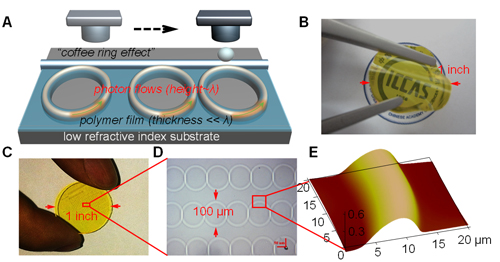ICCAS realized organic printed photonic circuits
Photonic integrated devices and circuits take advantages of fast transport speed, short response delay, and high capability of parallel computing, which may greatly compensate the shortcomings of nowadays interrogated electronic circuits. Based on the marvelous photo-physical and photo-chemical processes, as well as the chemical versatility, organic materials with photonic properties have attracted ever increasing attention. The CAS Key Laboratory of Photochemistry in Institute of Chemistry, Chinese Academy of Sciences (ICCAS) has been putting efforts on organic nanophotonic materials and functional devices over decades. They have achieved great successes on the controllable synthesis of micro-/nanostructures (Acc. Chem. Res. 2010, 43, 409-418;J. Am. Chem. Soc. 2015, 137, 62-65), and the realization of specific photo-functional devices (Acc. Chem. Res. 2014, 47, 3448-3458; Chem. Soc. Rev. 2014, 43, 4325-4340).
In spite of the excellent light transport and optical responsive properties of organic materials, the large scale, highly reproducible construction of their optical structures is still challenging. Very recently, Prof. Yong Sheng Zhao’s group in the CAS Key Laboratory of Photochemistry, in collaboration with the colleagues in CAS Key Laboratory of Organic Solids and University of Science and Technology of China (USTC), has achieved breakthrough in this area. A new paradigm shift is proposed for the manufacturing of large area, flexible, printed organic photonics. Just as photolithography is the traditional technique used in silicon photonics and electronics, Zhao et al. developed a solution-printing strategy for the function-directed, controllable and rapid fabrication of high-quality organic photonic devices and integrated circuits (Fig. 1). The printed photonic systems show competitive performance compared to their silicon-based counterparts (Fig. 2). In addition, they offer mild processing, flexible doping, and active/responsive characteristics. In light of the rapidly growing flexible electronics market in the past few years, this work promises a bright future for the manufacturing of flexible photonic circuits. The results have been published as “Organic printed photonics: from microring lasers to integrated circuits”, Science Advances 2015, 1, e1500257.

Fig. 1 Design and fabrication of a wafer-scale organic printed photonic chips

Fig. 2 Organic photonic integrated circuits based on the printed microstructures





